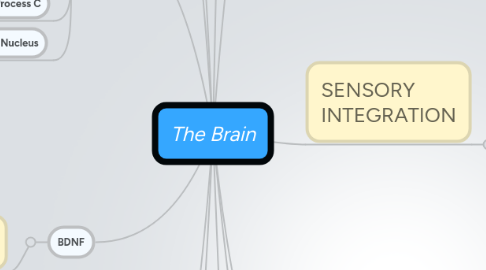
1. BDNF
1.1. STRESS
1.1.1. 3 Part Definiton
1.1.1.1. Measurable Pyschological Response
1.1.1.2. Desire to Avoid the Situation
1.1.1.3. A loss of Control
1.1.2. Effects
1.1.2.1. Memory and Problem Solving
1.1.2.1.1. Decreases
1.1.2.2. Cordiovascular
1.1.2.2.1. Scars Blood Vessels
1.1.2.3. Immune System
1.1.2.3.1. Lowers
2. _
2.1. Process S
2.1.1. SLEEP
2.1.1.1. During Sleep
2.1.1.1.1. Brain Repeats New Learning
2.1.1.2. Lack of Sleep
2.1.1.2.1. Decreased Working Memory
2.1.1.2.2. Decreased Executive Functions
2.1.1.2.3. Cripples Thinking
2.1.1.2.4. Increases Aging
2.1.1.2.5. Dcreases Insulin
2.2. Process C
2.2.1. Wants You to be Awake all the time
2.3. Suprachiasmatic Nucleus
2.3.1. Your Internal Clock
3. EVOLUTION
3.1. Cortex
3.1.1. Prefrontal Cortex
3.1.1.1. Executive Functions
3.1.1.1.1. SOLVING PROBLEMS
3.1.1.1.2. MAINTAINING ATTENTION
3.1.1.1.3. INHIBITING EMOTIONAL IMPULSES
4. EXERCISE
4.1. Increases access to Oxygen
4.1.1. MORE ENERGY FOR THE BRAIn
4.2. Increases Thinking Skills
4.3. Increases Cognitive Performance
4.4. Helps fight Depression
5. WIRING
5.1. Learning causes physical changes to the wiring
5.1.1. These Changes are Uniques to Individuals
5.2. Everyone's Brain is Wired Differently
5.3. A lot of the brain is wired to NOT be hard-wired
5.3.1. We are hard-wired to be flexible
6. EXPLORATION
6.1. We Are Powerful Natural Explorers
6.1.1. Babies are the perfect Model
6.1.1.1. They actively test their environment
6.1.2. We are Hard-wired to be this Way
6.1.2.1. Goes back to Evolution
6.1.2.2. Right Prefrontal Cortex checks our Hypotheses
6.1.2.3. Another Region tells us to change the behavior
6.2. Mirror Neurons
6.2.1. Allow us to recognize and imitate behaviors form our environment
6.3. Hard-Wired to be Flexible
6.3.1. Parts of Adult's brains stay as malleable as baby's
6.3.2. This way we can create neurons and continue learning throughout our lives
7. ATTENTION
7.1. The more attention we give something, the better we will learn it.
7.2. 3 Networks
7.2.1. Alerting Network
7.2.2. Orienting Network
7.2.3. Executive Network
7.3. Multitasking is a Myth
7.3.1. Brain naturally focuses on things one at a time
7.4. More Attention to
7.4.1. Emotionally Charged Events
7.4.2. The gist of something, not the details
7.5. Only lasts 10 minutes...
7.5.1. Then you need to grab it again
8. MEMORY
8.1. Dcelarative Memory
8.1.1. Encoding
8.1.1.1. Initial moment of learning
8.1.1.2. Content is stored seperately from its Context
8.1.1.3. Involves all of the senses
8.1.1.3.1. Recreate the Environment, to remember better
8.1.2. Working Memory is the bridge between Encoding and Storage
8.1.2.1. Must be held there long enough, or will not store
8.1.3. Storing
8.1.4. Retrieving
8.1.5. Forgetting
8.2. Initial Moments are Vital
8.2.1. 90% of learning is gone after 30 days
8.2.2. This is why we must engrain the inofrmation as early as possible
8.3. Consolidation
8.3.1. Transforming Short Term to
8.3.2. Long Term
8.3.2.1. Can take years for information to be grounded in the Cortex
8.3.2.2. Best way to store is to repeat gradually over time
9. SENSORY INTEGRATION
9.1. Brain takes energies from our environment and
9.2. Converts info into Electric Language for the brain
9.2.1. Then it is routed to it's appropriate region for processing
9.2.1.1. Later it will Renconstruct the data into one
9.3. People interpret the same event differently...
9.3.1. Brain relies on past experience to recombine the data
9.4. Senses Work Together
9.4.1. Thalamus
9.4.1.1. Hearing
9.4.1.2. Touch
9.4.1.3. Taste
9.4.1.4. Sight
9.4.2. Smells
9.4.2.1. Bypasses the Thalamus
9.4.2.2. Boost Memeory by themselves
9.4.3. Best to combine them together for Memory
10. VISION
10.1. Most Dominant Sense
10.1.1. Uses half of our brain's resources
10.2. We see an opinion of what our Brain thinks is out there
10.2.1. The brain interpolates info coming from each eye, then supplies it's best guess
10.3. Pictorial Superiority Effect
10.3.1. More visual input = More likely to be recognized/recalled
10.3.2. Pictorial Information is much more attractive to people
10.3.3. The brain sees words as a bunch of tiny little pictures, which is not as attractive
11. MUSIC
11.1. We are hard-wired for Music at birth
11.2. Boosts Language Skills
11.3. creates Better Listeners
11.4. Boosts Spatiotemporal Skills
11.4.1. Ability to rotate 3D objects in your head
11.5. Improves Working Memory
11.6. Music Training Affects Aspects of Speech
11.7. Improves Social Skills
11.7.1. Better at detecting Emotion in Speech
11.7.2. Empathy Skills Improve
12. GENDER
12.1. The X Choromosome
12.1.1. Women have 2
12.1.1.1. One Serves as a Back Up
12.1.1.2. Blend of Mom's and Dad's
12.1.2. Men have 1
12.1.2.1. All from Mom
12.1.2.2. Y is very Small by comparison
12.2. Different Brain Sturctures
12.2.1. We don't if the structural differences have any significance though
12.3. Left Vs Right
12.3.1. At Rest
12.3.1.1. Men's Right Brain is more active
12.3.1.2. Women's Left Brain is more active
12.3.2. Women Activate the Left Hemisphere amygdala
12.3.2.1. Remember emotional details
12.3.3. Men Activate Right Hemisphere Amygdala
12.3.3.1. Remember the gist
